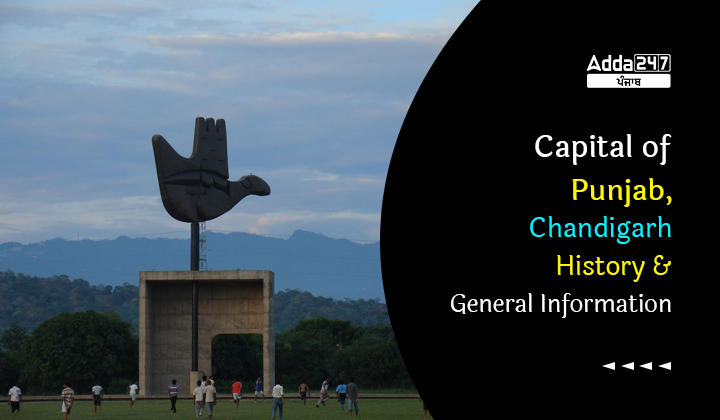What Is The Capital Of Punjab
The capital of Punjab is Chandigarh, a city and autonomous territory, the foundation stone of the capital of Punjab was laid in 1952. Chandigarh was renamed as Punjab Development from 1952 to 1966. On one side this area is with Punjab state and on the other side with the state. of the state. It is located around (265) to the north of Utcha Delhi. It is situated between two weathered hills in the updated southwest Indo-Gangetic plain of the Shichwalik Range. It is a climatic region of land that is flat and fertile, and its rural fields grow crops including rice, corn, and wheat. Winter temperatures (November to February) can drop to the mid-30s F (about 2 °C), while summer temperatures (April to June) can exceed 120 °F (about 50 °C).
Capital Of Punjab: Boundaries And Formation
The Union Territory is a 44-mile-wide area (114 sq km). The population of Chandigarh in 2011 is 960,787 and in 2001 the population was 808,515. On 1 June 1984, the Governor of Punjab took over the direct administration of the Union Territory of Chandigarh as Administrator from the Chief Commissioner.
The Capital of Punjab Chandigarh has some towns and several nearby villages which all fall under Chandigarh limits. The capital of the region, as well as the states of Punjab and Haryana, is Chandigarh. Chandi Mandir, a temple dedicated to the goddess located near the village of Mani Majra, is where the name Chandigarh, meaning “stronghold of goddess Chandi”, originates.
Capital Of Punjab: Chandigarh General Information
Chandigarh, the capital of Punjab, is located in the foothills of the Himalayas, Lee Corbusier, a Swiss-born architect, developed the city with the help of Maxwell Fry, Jane Drew, and several Indian architects and town planners.
Most of the city was finished in the early 1960s after construction began in the early 1950s. Ultimately, the project required the relocation of approximately 21,000 residents from 58 communities. When the Indian Punjab was divided into two new states on 1 November 1966 on the basis of linguistic affinity, the predominantly Hindi-speaking Haryana and the Punjabi-speaking Punjab-Chandigarh Union Territory were formed.।The city of Chandigarh, which is surrounded by the states of Haryana, Punjab and the Union Territory, was designated as the joint capital of the three.
Capital Of Punjab: Chandigarh Geographical Information
The former British province of Punjab was divided into two parts after the partition of India in 1947. Much of the western part, which included the capital of Punjab, Lahore, was taken over by Pakistan. India was given the eastern part, but it lacked an economic, cultural or governmental hub. The present location of Chandigarh was selected by the Government of India in 1948 at (30 degrees 45 N) and (76 degrees 47 E)
| Geographical Information Of Chandigarh | |
| Geographical Area | 114 Km square |
| Altitude | 304-365 meter |
| Density | 9258 persons per sq km |
| Population | 10.55 lakh |
| Male Population | 5.80 lakh |
| Female Population | 4.75 lakh |
| Sex Ratio | 818 |
| Literacy Rate | 86 % |
Capital Of Punjab: Chandigarh Industries And Population
More than half of the Union Territory is occupied by Chandigarh city, which has a developed infrastructure and relatively low population density. There are more than 55 rectangular sectors connected by wide roads that handle the busy traffic of the city. The northern area of the city is home to the primary government structures.
The industrial districts are located to the southeast and are divided from the residential sections by a greenbelt lined with mango trees. The city has many important industries with electronics, pharmaceuticals, ceramic plumbing fittings, and electrical equipment being some of the major industries in the city.
Chandigarh is the southern part of the city where most of the residents of the area are concentrated. Hinduism is by far the most common religion, although Sikhs form a large part of the population.
Capital Of Punjab: Universities And Gardens In Chandigarh
The area is home to many academic and cultural institutions, such as the Government College of Art, the Government Medical College and Hospital, the Post Graduate Institute of Medical Education and Research, the Punjab Engineering College, and the Punjab University, which was established in 1947. was
In addition, there are several specialized art academies. Apart from a substantial collection of Pahari and Sikh paintings and sculptures from Gandhara, the local museum in Chandigarh also has pottery from the Indus Civilization, which existed between 2500-1700 BCE. The city is also famous for its vast rose garden and rock garden, which includes many sculptures made from scrap materials by self-taught artist Nek Chand.
Chandigarh has many sports and recreational facilities. The vast, man-made Sukhna Lake whose water originates from the Ghaggar River, located in the northeast, has emerged as the city’s main attraction for sightseeing and nightlife. There are also many community centres and sports complexes that are funded by the government. Many field hockey, cricket, rowing, and other athletes who compete nationally and internationally have trained at these locations.
Relatable Post:
| Punjab General Knowledge |
| Land of Five Rivers in India |
| List of famous Gurudwaras in Punjab |
| The Arms act 1959 History and Background |
| The Anand Marriage act of 1909 |
| Cabinet Ministers of Punjab |













